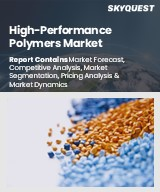
|
시장보고서
상품코드
1533006
바이오케톤 시장 - 예측(2024-2029년)Bio Ketones Market - Forecasts from 2024 to 2029 |
||||||
바이오케톤 시장은 예측 기간 중(2024-2029년) 7.92%의 복합 연간 성장률(CAGR)을 나타낼 것으로 예상됩니다.
바이오케톤 시장은 재생가능한 재료로부터 얻어지는 화학 화합물을 생물학적 프로세스로 합성, 사용하는 것으로, 환경을 배려하고 유용한 생리학적 특성을 가지고 있습니다. 이들 화합물은 바이오메틸에틸케톤(MEK), 바이오폴리에테르에테르케톤(PEEK), 바이오아세톤 등을 포함합니다. 바이오케톤은 주로 페인트 및 코팅 산업에서 용매로, 생물학적 유체, 유압 유체 및 방부제로 사용됩니다. 또한 폴리에스테르, 아크릴, 에폭시, 염화비닐 및 비닐아세테이트 공중합체, 니트로셀룰로오스, 알키드 등 다양한 유형의 수지에 적당한 용해성을 주어 용제에 가까운 증발 능력을 가지고 있습니다. 바이오케톤은 자동차, 항공우주, 인프라, 제약 등의 분야에서 널리 사용되고 있으며, 세계 시장에서 환경 친화적인 재료에 대한 관심 증가가 바이오케톤 시장을 촉진하는 주요 요인이 되고 있습니다.
- 바이오케톤 시장이 크게 확대되고 있는 것은 현재 세계 시장에서 바이오 제품의 인기가 높아지고 인공 제품에 대한 지속적인 환경 소동 때문입니다. 바이오케톤은 재생가능한 원료로부터 합성되기 때문에 석유계 용매의 많은 것보다 환경 프로파일이 우수합니다. 지속가능성에 대한 고객의 의식과 정부의 행동으로 환경친화적인 화학물질이 요구되고 있습니다. 이 추세는 바이오케톤 용제가 주요 용도 중 하나인 페인트 및 코팅과 같은 산업에서 두드러집니다. 윤활유는 자동차 및 항공우주 분야에서의 용도 중 하나이며 환경 규제와 고객의 요구에 따라 바이오 재료가 일반적으로 사용됩니다. 바이오케톤 시장의 주요 촉진요인 중 하나는 바이오 부문으로 분류되는 제품을 사용하는 이점에 대한 인식이 높아지고 있다는 것입니다.
- 바이오케톤 시장의 성장을 가속하는 또 다른 요인은 주로 많은 독특한 문제를 해결하는 능력에 의한 적응성입니다. 이러한 유기 화합물의 용도는 운송, 항공, 건설, 의료 등 다양합니다. 바이오케톤은 페인트, 코팅, 자동차 및 항공우주 산업에서 발견되는 것도 포함하며, 자동차 및 항공기 부품은 바이오케톤으로 개선되어 복합재료의 우수한 성능과 내구성을 제공합니다. 인프라 산업에서는 실란트 접착제 및 코팅제에 사용됩니다. 제약 산업에서의 바이오케톤의 용도로는 용제나 방부제 등이 있습니다. 이와 같이 새로운 용도가 개발되면 바이오케톤의 소비량이 증가의 길을 따라갈 것이라고 결론지어집니다. 이는 화합물이 다목적이고 다양한 최종 이용 산업에서 사용될 수 있음을 의미하며, 이는 시장을 활성화하는 주요 요인이기 때문입니다.
- 지속가능성과 바이오 재료 및 제품을 위한 정부의 장려책과 법규제의 유무도 바이오케톤 시장을 강화하고 있습니다. 세계의 대부분의 국가는 화석 자원의 사용을 단계적으로 줄이는 방법으로 녹색 화학 사용에 대한 의무적 조치와 보상금 사용을 채택하고 있습니다. 그러므로 유럽연합(EU)은 여러 분야에서 재생가능한 재료를 일정량 소비하거나 도입하는 목표를 정하고 있습니다. 마찬가지로 미국은 바이오 기술에 투자하는 기업에게 세액 공제 및 기타 모든 정책적 인센티브를 내놓고 있습니다. 이러한 정부의 움직임은 최종 사용자와 제조업체가 보다 친환경적인 선택을 추구할 수 밖에 없기 때문에 바이오케톤 시장에 좋은 조건을 키우고 있습니다. 또한 환경 관련법의 강도가 높아지고 있는 것도 바이오케톤 시장을 뒷받침하고 있는 여러가지 용도에 바이오 베이스의 솔루션을 채용하는 방향으로의 변화를 업계에 촉구하는 요인이 되고 있습니다.
바이오케톤 시장 성장 촉진요인
- 최종 사용자 산업별로는 페인트 및 코팅 분야가 예측 기간 중에 가장 급성장할 가능성이 높습니다.
페인트 및 코팅은 최종 사용자에 따라 분류되며 건축용 페인트 부문과 산업용 페인트 부서가 있습니다. 산업 부문의 공실률도 평가 연수 중에 크게 성장할 것으로 예상되며, 예측 기간 동안 일부 하위 부문이 최대 성장률을 나타낼 것으로 예상됩니다.
- 자동차 및 운송 : 자동차 및 운송 부문은 산업용 페인트 및 코팅 시장의 주요 소비자입니다. 세계화가 진행되고, 보다 저렴한 생산에 주목이 모이는 가운데, 자동차 시장은 특히 중국 등의 신흥 경제국에서 증가 경향에 있어, 인도에서는 고성능의 자동차가 요구되고 있기 때문에 고성능의 자동차 부품용 코팅에 대한 수요가 증가하고 있습니다. 오늘날 제조 업체는 더 나은 외관, 긴 수명, 환경 친화적인 코팅을 적용하려고 합니다. 이는 스크래치 저항성, 자가 수리성, 낮은 배출 가스 기능과 같은 공정을 가진 코팅에 포함되어 있습니다. 전력을 사용하는 자동차 모델의 채용 증가도 이러한 신기술에 적합한 특수 코팅 수요 증가에 영향을 미치고 있습니다.
- 항공우주 및 방위 : 항공우주 및 방위 산업도 산업용 페인트 및 코팅 수요를 어느 정도 밀어 올리고 있는 주요 최종 사용자입니다. 이 분야에서 사용되는 페인트는 내열성, 내화학성, 내마모성 등 성능 및 안전성에 대한 높은 요구 사항을 충족해야 합니다. 항공우주용 도료 시장 예측에 대해서는 국제 항공의 끊임없는 성장과 신형기의 등장에 의해 이러한 특수 도료에 대한 요구는 더욱 높아질 것이라고 말할 수 있습니다.
- 인프라 및 건설 : 건설 및 인프라와 관련된 산업은 산업용 페인트 및 코팅의 중요한 소비자입니다. 세계적으로 도시 인구가 증가하고, 다리나 도로 등의 인프라 건설에 대한 투자가 확대되고 있기 때문에 날씨에 의한 마모나 부식, 화재 등의 외적 요인으로부터 구조물을 보호하는 코팅이 필요합니다. 이러한 구조물의 대부분은 건설 프로젝트에 채용되기 때문에 구조물에 미관을 주는 코팅도 포함됩니다.
산업용 최종 용도 부문은 페인트 및 코팅 시장보다 높은 속도로 성장할 것으로 예상되므로 예측 기간 동안 가장 빠르게 성장하는 부문을 형성합니다. 이러한 산업은 엄격한 조건 하에서 운영되기 때문에 이러한 산업을 위한 고성능 페인트에 대한 수요가 이 성장률을 가속화시키는 중요한 요인이 되고 있습니다.
아시아태평양은 예측 기간 동안 바이오케톤 시장을 독점합니다.
일부 요인들로부터 아시아태평양(APAC) 지역은 예측 기간 동안 바이오케톤 시장을 선도할 것으로 예상됩니다. 아시아태평양은 중국, 인도, 일본 등 경제 성장과 산업화가 동시에 진행되고 있는 지역 중 하나입니다. 그 결과, 바이오케톤을 사용하는 페인트, 코팅 및 기타 산업용 응용 분야 시장이 증가하고 있습니다. 이 지역의 자동차 및 항공우주 사업 증가는 바이오케톤 제품에 대한 주요 수요 중 하나로 간주됩니다.
그 밖에 환경조건과 지속가능성에 대한 관심 증가도 시장성장의 요인이 되고 있습니다. 예를 들어, 최근 몇 년동안 아시아태평양의 일부 정부는 바이오 제품과 녹색 제품의 사용을 장려하기 위한 정책과 기준을 도입했습니다. 그러나 지속가능성 향상에 대한 소비자의 관심이 높아지면서 많은 산업에서 바이오케톤의 사용을 뒷받침하고 있습니다.
한편, 원가구조, 원재료 가용성 등의 요인은 자국측에 있는 것으로 보입니다. 비교적 아시아태평양은 바이오케톤 생산에 저렴한 노동력과 원료를 가지고 있기 때문에 또 다른 선호하는 장소입니다. 이 지역은 바이오 원료에 접근하기 쉽고 가까워 세계 바이오 케톤 시장의 체인에서 경쟁력을 더욱 높입니다.
바이오케톤은 아시아태평양의 다양한 산업에서 사용되며, 그 중에는 페인트 및 코팅제, 의약품, 인프라 등이 있습니다. 그 용도는 다양하기 때문에 새로운 용도가 출현할수록 이러한 화합물은 높은 수요가 예상되어 시장을 촉진하게 됩니다. 바이오케톤 시장 진출 기업은 현재 시장 성장에 맞추어 아시아태평양에 주목하여 생산 능력 증강에 투자하고 있습니다. 또한 기존 시장 포지션을 강화하고 합작 사업 형성을 통해 혁신을 촉진하기 위한 개발도 이루어지고 있습니다. 이러한 추세 외에도 아시아태평양의 인구 규모와 가처분 소득 증가 추세가 2023년까지 바이오케톤에 가장 유망한 시장이 되었습니다.
바이오케톤 시장은 다음과 같이 세분화되고 분석됩니다.
제품 유형별
- 바이오 MEK
- 바이오 PEEK
- 바이오아세톤
- 기타 제품 유형
최종 사용자 산업별
- 페인트 및 코팅
- 자동차
- 인프라
- 제약
- 기타 최종 사용자 산업
지역별
- 북미
- 미국
- 캐나다
- 멕시코
- 남미
- 브라질
- 아르헨티나
- 기타
- 유럽
- 영국
- 독일
- 프랑스
- 이탈리아
- 스페인
- 기타 유럽
- 중동 및 아프리카
- 사우디아라비아
- 아랍에미리트(UAE)
- 기타 중동 및 아프리카
- 아시아태평양
- 중국
- 인도
- 일본
- 한국
- 대만
- 태국
- 인도네시아
- 기타 아시아태평양
목차
제1장 서론
- 시장 개요
- 시장의 정의
- 조사 범위
- 시장 세분화
- 통화
- 전제조건
- 기준년 및 예측년의 타임라인
- 이해 관계자의 주요 이점
제2장 조사 방법
- 조사 디자인
- 조사 과정
제3장 주요 요약
- 주요 조사 결과
- 애널리스트 보기
제4장 시장 역학
- 시장 성장 촉진요인
- 화장품 및 퍼스널케어 업계로부터 수요 증가
- 바이오 제품의 사용에 관한 정부 규제의 지원
- 시장 성장 억제요인
- 원재료 부족
- 대체품으로부터의 위협
- Porter's Five Forces 분석
- 업계 밸류체인 분석
제5장 바이오케톤 시장 : 제품 유형별
- 서문
- 바이오 MEK
- 바이오 PEEK
- 바이오아세톤
- 기타 제품 유형
제6장 바이오케톤 시장 : 최종 사용자 산업별
- 서문
- 페인트 및 코팅
- 자동차
- 인프라
- 제약
- 기타 최종 사용자 산업
제7장 바이오케톤 시장 : 지역별
- 세계 개요
- 북미
- 미국
- 캐나다
- 멕시코
- 남미
- 브라질
- 아르헨티나
- 기타 남미
- 유럽
- 영국
- 독일
- 프랑스
- 이탈리아
- 스페인
- 기타 유럽
- 중동 및 아프리카
- 사우디아라비아
- 아랍에미리트(UAE)
- 기타 중동 및 아프리카
- 아시아태평양
- 중국
- 인도
- 일본
- 한국
- 대만
- 태국
- 인도네시아
- 기타 아시아태평양
제8장 경쟁 환경 및 분석
- 주요 기업 및 전략 분석
- 시장 점유율 분석
- 합병, 인수, 합의 및 콜라보레이션
- 경쟁 대시보드
제9장 기업 프로파일
- Bio Brands LLC
- Caldic BV
- Eastman Chemical Company
- Fitz Chem LLC
- Genomatica. Inc
- Green Biologics Limited
- LANZATECH
- Merck KGaA
The bio-ketones market is expected to register a compound annual growth rate (CAGR) of 7.92% during the forecast period (2024-2029).
The market of Bio-Ketones entails the synthesis and use of chemical compounds obtained from renewable materials in a biological process, which is environmentally sensitive and has useful physiological characteristics. These compounds are Bio Methyl Ethyl Ketone (MEK), Bio Polyether ether ketone (PEEK), and bio acetone among others. Bio-ketones are mainly used in paint and coating industry as a solvent, in Biological and hydraulic fluids and as preservatives. They also provide moderate solvency for various types of resins like polyesters, acrylics, epoxies vinyl chloride/vinyl acetate copolymers, nitrocellulose, and alkyds, about evaporation ability, which is similar to solvents. Bio-ketones are widely being used in the automotive, aerospace, infrastructural, and pharmaceutical sectors among others and the increasing concern towards ecofriendly materials in the global market are the major factors driving the Bio Ketone market.
- Bio-Ketones market is expanding heavily because of the rising popularity of bio-products in the current world market and the continual environmental uproar against artificial products. Bio-ketones are synthesized from renewable feedstocks hence have a better environmental profile than most of the petroleum-based solvents. Customer awareness of sustainability and actions by the governments have led to demand for environmentally friendly chemicals that are green in nature. This trend is most pronounced in industries such as paints and coatings where one of the key applications is the solvent in bio-ketones. Lubricants are another application in automotive and aerospace that is commonly using bio-based materials due to environment regulation and customer demand. One of the primary drivers for the Bio-Ketones market is the growing consciousness of the advantages of using products categorized under the bio-based segment.
- The other factor that is driving growth in the bio-ketones market is adaptability mainly due to their ability to solve many unique problems. Application of these organic compounds is diverse including transportation, aviation, construction, medicine, and so on. Bio-ketones including that found in paint, coating and automotive and aerospace industries; the constituents of auto and aircraft are improvised with bio-ketones to offer superior performance and durability of the composite. They use in the infrastructure industry in sealants adhesives and coatings. The uses of bio-ketones in the pharmaceutical industry include as solvents and preservatives. Thus, it can be concluded that with the development of new applications the consumption of bio-ketones will only increase. This is so because the compounds in question are versatile, meaning that they can be used in various end-use industries and this is a major driver that has been seen fueling the market.
- Availability of government incentives and legislations towards sustainability and bio-based materials and products are also bolstering the Bio-Ketones market. Most countries of the world have adopted the use of mandatory measures and rewards for the use of green chemicals as a way of phase out the use of fossil resources. For that purpose, the European Union has laid down goals to consume or incorporate a given volume of renewable materials in several areas. Likewise, the United States has come up with tax credit and every other policy incentive for corporations that invest in bio-based technologies. These governments' activities have fostered the right conditions for the Bio-Ketones market since the end-users and manufacturers are forced to seek greener options. The rising intensity of environmental laws is also another factor encouraging industries to make changes toward the adoption of bio-based solutions for several applications, which in return, helps boost the Bio-Ketones market.
BIO KETONES MARKET DRIVERS:
- The paints and coating segment by end-user industry is likely to be the fastest-growing segment during the forecast period.
The paints and coatings categorization is done according to the end users; a segment that has the architectural paints and industrial paints divisions. Vacancy in the industrial segment is also expected to grow significantly in the assessing years; some subsegments are expected to demonstrate the maximum growth rate throughout the period of the forecast.
- Automotive and Transportation: Automotive and transportation sector is a major consumer of industrial paints and coatings market. With increasing globalization and focus to cheaper production, the automotive market is on the rise especially in new economies such as China, Indian for high performing vehicles hence the high demand for high performing automotive part coatings. Today manufacturers are applying enhanced coatings that have better appearance, longer life, and are also eco-friendly. This is contained in coatings that possess processes such as scratch resistant, self-healing and low emission capabilities. An increase in the adoption of car models that use electric power is also affecting the increase in demand for specific coatings suitable for these new technologies.
- Aerospace and Defense: The aerospace and defense industry is still another primary end user that is fueling the demand for industrial paints and coatings to some extent. Coatings that are applied in this segment need to conform to high requirements for performance and safety such as heat and chemical resistant, wearing and abrasion resistance. Concerning the future forecast of the aerospace coatings market it can be stated that due to the constant growth of international aviation and the appearance of new models of planes the need for these specialized coatings will be even higher.
- Infrastructure and Construction: The industries related to construction as well as infrastructure are also important consumers of industrial paints and coatings. Since, global population expands in cities, and extend the investments in infrastructure construction like bridges, roads and other properties, there is the need for protective coatings for structures from outside factors such as wearing effects of weather, corrosion, and fire. This includes coatings that give the structures an aesthetic feel since most of these structures are employed in the construction projects.
The industrial end-use segments are expected to grow at a higher pace than the paint and coatings' market and thus form the fastest-growing segments during the forcast period. The demand for high-performance coatings for these industries is an essential driver of this faster growth rate since the industries operate under strict conditions.
Asia Pacific region to dominate the bio ketones market during the forecast period.
Due to several factors the Asia-Pacific (APAC) region is expected to lead the Bio-Ketones market during the forecast period. APAC is one of the region that is growing economically and industrializing most at the same time with China, India, Japan among others. This has in turn resulted into increase in the market for paints, coatings and other industrial purposes which use bio-ketones. The increased automotive and aerospace business in the area is considered to be one of the key demands for bio-ketone products.
Other factors that are contributing to the growth of the market are increasing concerns for environmental conditions and sustainability. To illustrate, over the last few years, several governments in the Asia-Pacific region introduced policies and standards aimed at encouraging the use of bio-based and green products. Yet, rising concerns of consumers with sustainability improvements has boosting the use of bio-keton in many industries.
On the other hand such factors as cost structures, the availability of raw materials etc were seen on the side of the home country. Comparatively, APAC is another preferred location as it has cheap labor and raw material for the production of bio-ketone. This has further boosted its competitiveness in the chain of global bio-ketones market since the region determines easy and close access to bio-based feedstock.
Bio-ketones are used across various industries of APAC some of which are paints and coatings, pharmaceuticals as well as infrastructure. Because of their varied applications, these compounds are likely to be in high demand as the new applications surface hence driving the market. Bio-ketones market participants are now looking at APAC as the market grows and invest in increasing production capacity. Others are also being developed to enhance the existing market position and encourage innovation through formation of joint ventures. Such factors further complemented with the size of the population bog and increasing trend of disposable income in APAC make the geography the most prospective market for bio-ketones till the year 2023.
The bio-ketones market is segmented and analyzed as follows:
By Product Type
- Bio MEK
- Bio PEEK
- Bio Acetone
- Other Product Types
By End-User Industry
- Paints and Coatings
- Automobile
- Infrastructure
- Pharmaceutical
- Other End-user Industries
By Geography
- North America
- USA
- Canada
- Mexico
- South America
- Brazil
- Argentina
- Others
- Europe
- United Kingdom
- Germany
- France
- Italy
- Spain
- Rest of Europe
- Middle East and Africa
- Saudi Arabia
- Saudi Arabia
- United Arab Emirates
- Rest of Middle East and Africa
- Asia-Pacific
- China
- India
- Japan
- South Korea
- Taiwan
- Thailand
- Indonesia
- Rest of Asia-Pacific
TABLE OF CONTENTS
1. INTRODUCTION
- 1.1. Market Overview
- 1.2. Market Definition
- 1.3. Scope of the Study
- 1.4. Market Segmentation
- 1.5. Currency
- 1.6. Assumptions
- 1.7. Base and Forecast Years Timeline
- 1.8. Key benefits for the stakeholders
2. RESEARCH METHODOLOGY
- 2.1. Research Design
- 2.2. Research Process
3. EXECUTIVE SUMMARY
- 3.1. Key Findings
- 3.2. Analyst View
4. MARKET DYNAMICS
- 4.1. Market Drivers
- 4.1.1. Increasing Demand from the Cosmetics and Personal Care Industry
- 4.1.2. Supporting Government Regulations for the Use of Bio-products
- 4.2. Market Restraints
- 4.2.1. Scarcity of Raw Materials
- 4.2.2. Threats from Substitutes
- 4.3. Porter's Five Forces Analysis
- 4.3.1. Bargaining Power of Suppliers
- 4.3.2. Bargaining Power of Buyers
- 4.3.3. The Threat of New Entrants
- 4.3.4. Threat of Substitutes
- 4.3.5. Competitive Rivalry in the Industry
- 4.4. Industry Value Chain Analysis
5. BIO KETONES MARKET BY PRODUCT TYPE
- 5.1. Introduction
- 5.2. Bio MEK
- 5.3. Bio PEEK
- 5.4. Bio Acetone
- 5.5. Other Product Types
6. BIO KETONES MARKET BY END-USER INDUSTRY
- 6.1. Introduction
- 6.2. Paints and Coatings
- 6.3. Automobile
- 6.4. Infrastructure
- 6.5. Pharmaceutical
- 6.6. Other End-user Industries
7. BIO KETONES MARKET BY GEOGRAPHY
- 7.1. Global Overview
- 7.2. North America
- 7.2.1. United States
- 7.2.2. Canada
- 7.2.3. Mexico
- 7.3. South America
- 7.3.1. Brazil
- 7.3.2. Argentina
- 7.3.3. Rest of South America
- 7.4. Europe
- 7.4.1. United Kingdom
- 7.4.2. Germany
- 7.4.3. France
- 7.4.4. Italy
- 7.4.5. Spain
- 7.4.6. Rest of Europe
- 7.5. Middle East and Africa
- 7.5.1. Saudi Arabia
- 7.5.2. United Arab Emirates
- 7.5.3. Rest of Middle East and Africa
- 7.6. Asia-Pacific
- 7.6.1. China
- 7.6.2. India
- 7.6.3. Japan
- 7.6.4. South Korea
- 7.6.5. Taiwan
- 7.6.6. Thailand
- 7.6.7. Indonesia
- 7.6.8. Rest of Asia-Pacific
8. COMPETITIVE ENVIRONMENT AND ANALYSIS
- 8.1. Major Players and Strategy Analysis
- 8.2. Market Share Analysis
- 8.3. Mergers, Acquisitions, Agreements, and Collaborations
- 8.4. Competitive Dashboard
9. COMPANY PROFILES
- 9.1. Bio Brands LLC
- 9.2. Caldic B.V.
- 9.3. Eastman Chemical Company
- 9.4. Fitz Chem LLC
- 9.5. Genomatica. Inc
- 9.6. Green Biologics Limited
- 9.7. LANZATECH
- 9.8. Merck KGaA



















